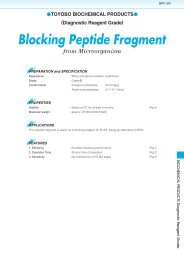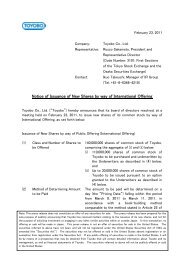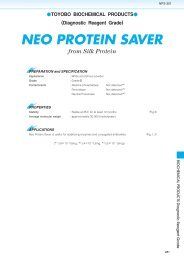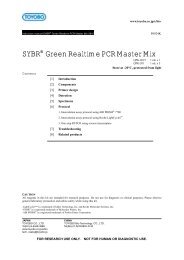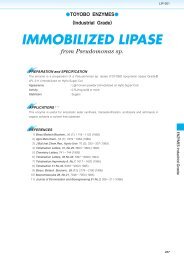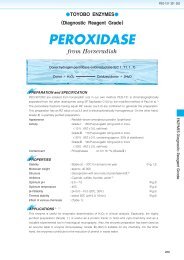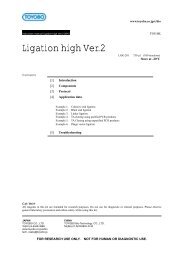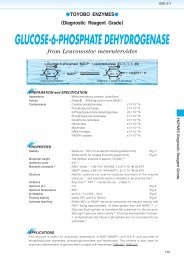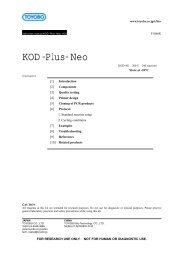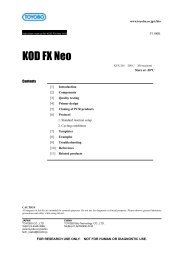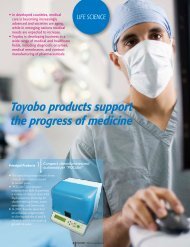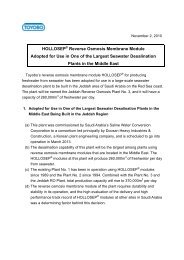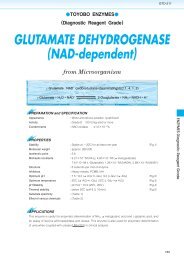KOD FX - Toyobo
KOD FX - Toyobo
KOD FX - Toyobo
You also want an ePaper? Increase the reach of your titles
YUMPU automatically turns print PDFs into web optimized ePapers that Google loves.
www.toyobo.co.jp/e/bio<br />
Instruction manual <strong>KOD</strong> <strong>FX</strong> 0905<br />
F0935K<br />
<strong>KOD</strong> <strong>FX</strong><br />
K<strong>FX</strong>-101 200 U 200 reactions<br />
Store at -20°C<br />
Contents<br />
[1] Introduction<br />
[2] Components<br />
[3] Quality testing<br />
[4] Primer design<br />
[5] Cloning of PCR products<br />
[6] Protocol<br />
1. Standard reaction setup<br />
2. Cycling conditions<br />
[7] Amplification from crude samples<br />
[8] Optimization of PCR conditions<br />
[9] Trouble shooting<br />
[10] References<br />
[11] Related products<br />
CAUSION<br />
All reagents in this kit are intended for research purposes. Do not use for diagnosis or clinical purposes. Please observe general laboratory<br />
precaution and utilize safety while using this kit.<br />
JAPAN<br />
TOYOBO CO., LTD.<br />
Tel(81)-6-6348-3888<br />
www.toyobo.co.jp/e/bio<br />
tech_osaka@toyobo.jp<br />
CHINA<br />
TOYOBO Bio-Technology, CO., LTD.<br />
Tel(86)-21-58794900.4140<br />
1<br />
FOR RESEARCH USE ONLY. NOT FOR HUMAN OR DIAGNOSTIC USE.
www.toyobo.co.jp/e/bio<br />
[ 1 ] Introduction<br />
Description<br />
<strong>KOD</strong> <strong>FX</strong> is based on DNA polymerase from the hyperthermophilic Archaeon<br />
Thermococcus kodakaraensis <strong>KOD</strong>1 1) 2) . <strong>KOD</strong> <strong>FX</strong> results in much greater PCR success<br />
based on efficiency and elongation capabilities than <strong>KOD</strong> -Plus- (Code No. <strong>KOD</strong>-201)<br />
or other Taq-based PCR enzymes. <strong>KOD</strong> <strong>FX</strong> enzyme solution contains two types of<br />
anti-<strong>KOD</strong> DNA polymerase antibodies that inhibit polymerase and 3’5’ exonuclease<br />
activities, thus allowing for Hot Start PCR 3) . <strong>KOD</strong> <strong>FX</strong> generates blunt-end PCR products,<br />
due to 3’5’ exonuclease (proof-reading) activity.<br />
Features<br />
-This enzyme is effective for the amplification of GC-rich targets and crude samples.<br />
-Hotstart technology using anti-<strong>KOD</strong> DNA polymerase antibodies enables highly<br />
efficient amplification.<br />
-<strong>KOD</strong> <strong>FX</strong> enables the following amplifications (Maximum): 40kb from lambda phage<br />
DNA, 24kb from human genomic DNA, and 13.5kb from cDNA.<br />
-The PCR error ratio of <strong>KOD</strong> <strong>FX</strong> is about 10 times less than that of Taq DNA<br />
polymerase.<br />
Table 1. Comparison of the mutation frequency of each PCR enzyme.<br />
Total bases<br />
Sequenced<br />
Number of<br />
mutated bases<br />
Mutation frequency<br />
(x10 -5 )<br />
<strong>KOD</strong> <strong>FX</strong> 144,535 19 13.1<br />
<strong>KOD</strong> -Plus- 145,753 5 3.4<br />
Pfu DNA polymerase 113,080 12 10.6<br />
Taq-base long-PCR enzyme 167,343 218 130.3<br />
Taq DNA polymerase 102,708 145 141.2<br />
Fidelity was measured as a mutation frequency by sequencing the PCR product. After cloning the<br />
PCR product (2.4kb of the human bata-globin region), about 96 clones were selected and sequenced.<br />
[ 2 ] Components<br />
This reagent includes the following components for 200 reactions;<br />
<strong>KOD</strong> <strong>FX</strong> (1.0 U/μl) * 200 μl × 1<br />
2× PCR Buffer for <strong>KOD</strong> <strong>FX</strong>** 1.7 ml × 3<br />
2 mM dNTPs 1 ml × 2<br />
*The enzyme solution contains anti-<strong>KOD</strong> DNA polymerase antibodies that neutralize<br />
polymerase and 3’5’ exonuclease activities.<br />
** 2× PCR Buffer for <strong>KOD</strong> <strong>FX</strong> is a liquid (not congealed) when in storage at -20°C.<br />
Although it does congeal below -20°C, the quality is not affected.<br />
[ 3 ] Quality Testing<br />
Quality check is performed by amplification of the tPA gene (24kb).<br />
JAPAN<br />
TOYOBO CO., LTD.<br />
Tel(81)-6-6348-3888<br />
www.toyobo.co.jp/e/bio<br />
tech_osaka@toyobo.jp<br />
CHINA<br />
TOYOBO Bio-Technology, CO., LTD.<br />
Tel(86)-21-58794900.4140<br />
1<br />
FOR RESEARCH USE ONLY. NOT FOR HUMAN OR DIAGNOSTIC USE.
www.toyobo.co.jp/e/bio<br />
[ 4 ] Primer Design<br />
-Primers should be 22-35 bases with a melting temperature (T m ) over 60°C. For<br />
amplification of a long target, 25-35 bases with high T m values (≥ 65°C) are<br />
recommended. The primer Tm value for the 2-step or step-down cycles should be ≥<br />
65°C.<br />
-For amplification of longer targets (≥ 10kb), primer oligonucleotides should be<br />
cartridge- or HPLC- purified. Primers purified by gel filtration tend to result in smeared<br />
PCR products.<br />
[ 5 ] Cloning of<br />
PCR products<br />
-<strong>KOD</strong> <strong>FX</strong> generates blunt-end PCR products, due to 3’5’ exonuclease (proof-reading)<br />
activity. Therefore, the product can be cloned according to a blunt-end cloning method.<br />
-PCR products of <strong>KOD</strong> <strong>FX</strong> should be purified prior to restriction enzyme treatments. The<br />
3’5’ exonuclease activity of <strong>KOD</strong> DNA polymerase remains after the PCR cycles.<br />
[ 6 ] Protocol<br />
1. Standard reaction setup<br />
The following protocol is designed for use with the components provided in this kit.<br />
Before preparing mixture, all components should be completely thawed, except for the<br />
enzyme solution.<br />
Component Volume Final Concentration<br />
2x PCR buffer for <strong>KOD</strong> <strong>FX</strong> 25 μl 1×<br />
2mM dNTPs* 10 μl 0.4 mM each<br />
10pmol /μl Primer #1 1.5 μl 0.3 μM<br />
10pmol /μl Primer #2 1.5 μl 0.3 μM<br />
Genomic DNA ≤200 ng / 50 μl<br />
Template DNA<br />
X μl Plasmid DNA ≤50 ng / 50 μl<br />
cDNA ≤200 ng (RNA equiv.) / 50 μl<br />
Crude sample ≤0.5-4 μl (see [ 7 ])<br />
PCR grade water<br />
Y μl<br />
<strong>KOD</strong> <strong>FX</strong> (1.0U/μl) 1 μl 1.0 U / 50 μl<br />
Total reaction volume 50 μl<br />
* Do not use dNTPs from other kits or companies.<br />
Notes:<br />
-For PCR reaction, thin-wall tubes are recommended. Reaction setup to a total reaction<br />
volume of 50 μl is also recommended.<br />
-Addition of DMSO (final conc. 2-5%) might be effective for amplification of GC-rich<br />
target. No decreasing of the PCR fidelity by adding DMSO has been confirmed.<br />
-Crude samples (e.g., cultured animal cell suspension) should be added up to 2 μl for<br />
each 50-μl reaction.<br />
JAPAN<br />
TOYOBO CO., LTD.<br />
Tel(81)-6-6348-3888<br />
www.toyobo.co.jp/e/bio<br />
tech_osaka@toyobo.jp<br />
CHINA<br />
TOYOBO Bio-Technology, CO., LTD.<br />
Tel(86)-21-58794900.4140<br />
2<br />
FOR RESEARCH USE ONLY. NOT FOR HUMAN OR DIAGNOSTIC USE.
www.toyobo.co.jp/e/bio<br />
2. Cycling conditions<br />
The following cycling steps are recommended.<br />
< 2-step cycle ><br />
Pre-denaturation :<br />
Denaturation :<br />
Extension :<br />
94°C, 2 min.<br />
98°C, 10 sec.<br />
68°C, 1 min. /kb<br />
25-40 cycles<br />
Note: If the Tm value of the primer is under 73 °C, the 3-step cycle is recommended.<br />
< 3-step cycle ><br />
Pre-denaturation :<br />
Denaturation :<br />
Annealing :<br />
Extension :<br />
94°C, 2 min.<br />
98°C,10 sec.<br />
Tm-[5-10]°C*, 30 sec.<br />
68°C, 1 min. /kb<br />
25-40 cycles<br />
*Tm value of the primer minus 5°C-10°C<br />
< Step-down cycle ><br />
Pre-denaturation :<br />
Denaturation :<br />
Extension :<br />
Denaturation :<br />
Extension :<br />
Denaturation :<br />
Extension :<br />
Denaturation :<br />
Extension :<br />
Extension :<br />
94°C,2 min.<br />
98°C,10 sec.<br />
74°C,1 min. /kb<br />
98°C,10 sec.<br />
72°C,1 min. /kb<br />
98°C,10 sec.<br />
70°C,1 min. /kb<br />
98°C,10 sec.<br />
68°C,1 min. /kb<br />
68°C,7 min.<br />
5 cycles<br />
5 cycles<br />
5 cycles<br />
15-25 cycles<br />
Note : If the Tm value of the primer is under 73 °C, the 3-step cycle is recommended.<br />
Notes:<br />
-Extension time should be set at 1min. per 1kbp of target length. Although even 30<br />
sec./ kb will give amplification in many cases, amplification efficiency or reliability<br />
may be decreased (See [ 8 ] Example 3).<br />
-Because this enzyme possesses an extremely high amplification efficiency, 25-30<br />
cycles usually give sufficient amplification. For a low-copy number target, or over 10<br />
kb target length, 30-40 cycles are recommended.<br />
-The step-down cycle condition is effective for trouble shooting a smear amplification<br />
in a long-distance PCR (>10kb).<br />
JAPAN<br />
TOYOBO CO., LTD.<br />
Tel(81)-6-6348-3888<br />
www.toyobo.co.jp/e/bio<br />
tech_osaka@toyobo.jp<br />
CHINA<br />
TOYOBO Bio-Technology, CO., LTD.<br />
Tel(86)-21-58794900.4140<br />
3<br />
FOR RESEARCH USE ONLY. NOT FOR HUMAN OR DIAGNOSTIC USE.
www.toyobo.co.jp/e/bio<br />
[ 7 ] Amplification from crude samples<br />
<strong>KOD</strong> <strong>FX</strong> exhibits superior efficiency when amplifying targets from crude samples (e.g.,<br />
whole blood, mouse tail lysate, and plant lysate). The following table lists specimens that<br />
have been successfully amplified with <strong>KOD</strong> <strong>FX</strong>. Certain samples require pretreatment<br />
prior to PCR. The pretreatment methods are described below.<br />
Pretreatment<br />
Not required<br />
Not required<br />
Not required<br />
Not required<br />
Not required<br />
Not required<br />
Not required<br />
Not required<br />
Lysis<br />
Lysis<br />
Lysis<br />
Sample<br />
Whole blood<br />
Dried blood on filter paper<br />
Cultured cells<br />
Yeast (colony)<br />
Bacteria (colony)<br />
Fungus (colony)<br />
Sperm<br />
Plankton<br />
Mouse tail<br />
Plant (leaf, rice grain, etc)<br />
Hair root<br />
(1) Amplification from not-treated samples<br />
<br />
The following samples can be applied directly to 50 μl of reaction mixture.<br />
-Whole blood:<br />
-Cultured cells:<br />
-Yeast, bacteria, and fungus:<br />
1-4 μl<br />
www.toyobo.co.jp/e/bio<br />
(2) Amplification from lysates<br />
(a) Mouse tail<br />
<br />
The following “Alkaline lysis method” is recommended for rapid preparation of<br />
mouse tail lysate suitable for amplification with <strong>KOD</strong> <strong>FX</strong>.<br />
<br />
Sample: mouse tail lysates prepared by “Alkaline lysis method” (0.5 μl/50 μl reaction)<br />
Taq-based high efficient<br />
PCR enzyme<br />
<strong>KOD</strong> <strong>FX</strong> Company A Company B<br />
M M M M<br />
Target: Mouse membrane glycoprotein<br />
(Thy-1) gene<br />
2.6 kb<br />
Cycling conditions:<br />
(n=2)<br />
M: 1 kb Ladder Marker<br />
Primer F :5’-CCACAGAATCCAAGTCGGAACTCTTG-3’<br />
Primer R :5’-GTAGCAGTGGTGGTATTATACATGGTG-3’<br />
94°C, 2 min.<br />
98°C, 10 sec.<br />
68°C, 2.5 min.<br />
30 cycles<br />
JAPAN<br />
TOYOBO CO., LTD.<br />
Tel(81)-6-6348-3888<br />
www.toyobo.co.jp/e/bio<br />
tech_osaka@toyobo.jp<br />
CHINA<br />
TOYOBO Bio-Technology, CO., LTD.<br />
Tel(86)-21-58794900.4140<br />
5<br />
FOR RESEARCH USE ONLY. NOT FOR HUMAN OR DIAGNOSTIC USE.
www.toyobo.co.jp/e/bio<br />
(b) Plant tissues<br />
<br />
The following “One-step method” is recommended for a rapid preparation of the<br />
plant tissue lysate suitable for amplification with <strong>KOD</strong> <strong>FX</strong>.<br />
*Buffer A is not supplied with this kit.<br />
<br />
Sample: Plant lysates prepared by “One-step method” (1 μl/50 μl reaction)<br />
Taq-based high efficient<br />
PCR enzyme<br />
<strong>KOD</strong> <strong>FX</strong> Company A Company B<br />
1 2 3 4 5 M 1 2 3 4 5 M 1 2 3 4 5<br />
Target: rbcL gene 1.3 kb<br />
Cycling conditions:<br />
1.3kb<br />
1: Leaf (Tomato)<br />
2: Leaf (Tobacco)<br />
3: Leaf (Rice)<br />
4: Grain (Rice)<br />
5: Purified rice leaf DNA<br />
94°C, 2 min.<br />
98°C, 10 sec.<br />
30 cycles<br />
68°C, 1.5 min.<br />
Primer F1:5’-ATGTCACCACAAACAGAGACTAAAGC-3’ (Tomato & Tobacco)<br />
Primer R1 :5’-AAGCAGCAGCTAGTTCCGGGCTCCA-3’ (Tomato & Tobacco)<br />
Primer F2::’-ATGTCACCACAAACAGAAACTAAAGC-3’ (Rice)<br />
Primer R2 :5’-AAGCTGCGGCTAGTTCAGGACTCCA-3’ (Rice)<br />
JAPAN<br />
TOYOBO CO., LTD.<br />
Tel(81)-6-6348-3888<br />
www.toyobo.co.jp/e/bio<br />
tech_osaka@toyobo.jp<br />
CHINA<br />
TOYOBO Bio-Technology, CO., LTD.<br />
Tel(86)-21-58794900.4140<br />
6<br />
FOR RESEARCH USE ONLY. NOT FOR HUMAN OR DIAGNOSTIC USE.
www.toyobo.co.jp/e/bio<br />
[ 8 ] Example<br />
Example 1.<br />
Large PCR products (≥10 Kb) with various number of cycles.<br />
A<br />
B C M<br />
Template: cDNA from Adult Skeletal Muscle total RNA<br />
100 ng equiv. / 50 μl<br />
Target: Dystrophin [NM_004006] 13.5 kb<br />
PCR cycling conditions:<br />
94 ℃ 2 min.<br />
98 ℃ 10 sec.<br />
68 ℃ 14 min. A:30 cycles<br />
B: 35 cycles C: 40 cycles<br />
M:λ/HindIII digest<br />
Example 2.<br />
Large PCR products (≥ 10 Kb) with various cycle conditions.<br />
A B M Template: Human Genomic DNA 200 ng / 50 μl<br />
Target: tPA 24 kb<br />
PCR cycling conditions:<br />
A<br />
94 ℃ 2 min.<br />
98 ℃ 10 sec.<br />
68 ℃ 24 min.<br />
30 cycles<br />
B<br />
94 ℃ 2 min.<br />
98 ℃ 10 sec.<br />
74 ℃ 24 min.<br />
98 ℃ 10 sec.<br />
72 ℃ 24 min.<br />
98 ℃ 10 sec.<br />
70 ℃ 24 min.<br />
98 ℃ 10 sec.<br />
68 ℃ 24 min.<br />
68 ℃ 7 min.<br />
5 cycles<br />
5 cycles<br />
5 cycles<br />
20 cycles<br />
Example 3. Correlation between amount of the template DNA and extension<br />
time.<br />
A<br />
B<br />
1 2 3 4 5 6 7 8 M 1 2 3 4 5 6 7 8<br />
Target: tPA 24kb<br />
Template:Human genomic DNA<br />
PCR cycling conditions:<br />
A<br />
94 ℃ 2 min.<br />
98 ℃ 10 sec.<br />
74 ℃ 12 min.<br />
98 ℃ 10 sec.<br />
72 ℃ 12 min.<br />
98 ℃ 10 sec.<br />
70 ℃ 12 min.<br />
98 ℃ 10 sec.<br />
68 ℃ 12 min.<br />
68 ℃ 7 min.<br />
5 cycles<br />
5 cycles<br />
5 cycles<br />
20 cycles<br />
B<br />
94 ℃ 2 min.<br />
98 ℃ 10 sec.<br />
74 ℃ 24 min.<br />
98 ℃ 10 sec.<br />
72 ℃ 24 min.<br />
98 ℃ 10 sec.<br />
70 ℃ 24 min.<br />
98 ℃ 10 sec.<br />
68 ℃ 24 min.<br />
68 ℃ 7 min.<br />
5 cycles<br />
5 cycles<br />
5 cycles<br />
20 cycles<br />
1: 6 ng / 50 μl<br />
2: 12 ng<br />
3: 25 ng<br />
4: 50 ng<br />
5: 100 ng<br />
6: 200 ng<br />
7: 400 ng<br />
8: 800 ng<br />
JAPAN<br />
TOYOBO CO., LTD.<br />
Tel(81)-6-6348-3888<br />
www.toyobo.co.jp/e/bio<br />
tech_osaka@toyobo.jp<br />
CHINA<br />
TOYOBO Bio-Technology, CO., LTD.<br />
Tel(86)-21-58794900.4140<br />
7<br />
FOR RESEARCH USE ONLY. NOT FOR HUMAN OR DIAGNOSTIC USE.
www.toyobo.co.jp/e/bio<br />
[ 9 ] Trouble shooting<br />
Symptom Cause Solution<br />
No PCR product / low yield<br />
Smearing / Extra band<br />
Cycling condition is not<br />
suitable.<br />
Primer is not good.<br />
Template DNA is not good<br />
in quality and/or quantity.<br />
Too much sample<br />
Cycling condition is not<br />
suitable.<br />
Primer is not good.<br />
Too much template DNA<br />
Too much enzyme<br />
Use 3-step instead of 2-step cycling.<br />
Lower annealing temperature in 3°C decrements up<br />
to Tm-10°C.<br />
Increase the number of cycles by 2-5 cycles.<br />
<br />
Check the quality of primers.<br />
Redesign primers.<br />
Check the quality of template DNA.<br />
Increase the amount of template DNA<br />
<br />
Excessive amounts of crude sample may inhibit<br />
amplification. Decrease the sample volume to 0.5<br />
µl/50 µl reaction.<br />
Decrease the number of cycles by 2-5 cycles.<br />
<br />
Use step-down cycling<br />
Check the quality of primers.<br />
Redesign primers.<br />
Reduce the amount of template DNA<br />
<br />
Reduce Enzyme to 0.5-0.8U/ 50μl reaction<br />
[ 10 ] References<br />
1) Takagi M, Nishioka M, Kakihara H, Kitabayashi M, Inoue H, Kawakami B, Oka M,<br />
and Imanaka T., Appl Environ Microbiol., 63: 4504-10 (1997)<br />
2) Hashimoto H, Nishioka M, Fujiwara S, Takagi M, Imanaka T, Inoue T and Kai Y, J<br />
Mol Biol., 306: 469-77 (2001)<br />
3) Mizuguchi H, Nakatsuji M, Fujiwara S, Takagi M and Imanaka T, J Biochem., 126:<br />
762-8 (1999)<br />
JAPAN<br />
TOYOBO CO., LTD.<br />
Tel(81)-6-6348-3888<br />
www.toyobo.co.jp/e/bio<br />
tech_osaka@toyobo.jp<br />
CHINA<br />
TOYOBO Bio-Technology, CO., LTD.<br />
Tel(86)-21-58794900.4140<br />
8<br />
FOR RESEARCH USE ONLY. NOT FOR HUMAN OR DIAGNOSTIC USE.
www.toyobo.co.jp/e/bio<br />
[ 11 ] Related products<br />
Product name Package Code No.<br />
TArget Clone -Plus- 10 reactions TAK-201<br />
10x A-attachment mix 25 reactions TAK-301<br />
Ligation high Ver.2<br />
750 μl<br />
(100 reactions)<br />
LGK-201<br />
TArget Clone -Plus- is a high efficient TA cloning kit. The kit can be applied to the TA<br />
cloning of blunt-end PCR products amplified using <strong>KOD</strong> -Plus- [Code No. <strong>KOD</strong>-201] or<br />
<strong>KOD</strong> <strong>FX</strong> [Code No. K<strong>FX</strong>-101]. The kit contains pTA2 Vector, 2x Ligation Buffer, T4<br />
DNA Ligase and 10x A-attachment Mix.<br />
10 x A-attachment mix is a reagent comprising anti-<strong>KOD</strong> DNA polymerase antibody<br />
specific to <strong>KOD</strong> 3’5’ exonuclease activity (proof-reading activity), as well as Taq DNA<br />
polymerase, which exhibits terminal transferase activity. PCR products from <strong>KOD</strong> -Plus-<br />
[Code No. <strong>KOD</strong>-201] and <strong>KOD</strong> <strong>FX</strong> [Code No. K<strong>FX</strong>-101] possess blunt ends due to<br />
3’5’ exonuclease activity of the <strong>KOD</strong> DNA polymerase. The 10 x A-attachment mix<br />
allows for PCR products to acquire overhanging dA at the 3’-ends. Products with 3’-dA<br />
overhangs can be directly cloned into arbitrary T-vectors using ligation reagents, such as<br />
Ligation high Ver.2 [Code No. LGK-201].<br />
<strong>KOD</strong> DNA polymerase<br />
Anti-<strong>KOD</strong> DNA polymerase<br />
antibody<br />
PCR product<br />
Inhibition of the<br />
proof-reading<br />
acitivity<br />
A<br />
A<br />
Addition of dA<br />
Taq DNA polymerase<br />
Fig.<br />
Principle of the 10 x A-attachment mix<br />
JAPAN<br />
TOYOBO CO., LTD.<br />
Tel(81)-6-6348-3888<br />
www.toyobo.co.jp/e/bio<br />
tech_osaka@toyobo.jp<br />
CHINA<br />
TOYOBO Bio-Technology, CO., LTD.<br />
Tel(86)-21-58794900.4140<br />
9<br />
FOR RESEARCH USE ONLY. NOT FOR HUMAN OR DIAGNOSTIC USE.
www.toyobo.co.jp/e/bio<br />
NOTICE TO PURCHASER: LIMITED LICENSE<br />
Use of this product is covered by one or more of the following US patents and corresponding patent claims outside the US: 5,079,352,<br />
5,789,224, 5,618,711, 6,127,155 and claims outside the US corresponding to US Patent No. 4,889,818. The purchase of this product<br />
includes a limited, non-transferable immunity from suit under the foregoing patent claims for using only this amount of product for the<br />
purchaser’s own internal research. No right under any other patent claim (such as the patented 5’ Nuclease Process claims in US Patents<br />
Nos. 5,210,015 and 5,487,972), no right to perform any patented method, and no right to perform commercial services of any kind,<br />
including without limitation reporting the results of purchaser's activities for a fee or other commercial consideration, is conveyed expressly,<br />
by implication, or by estoppel. This product is for research use only. Diagnostic uses under Roche patents require a separate license from<br />
Roche. Further information on purchasing licenses may be obtained by contacting the Director of Licensing, Applied Biosystems, 850<br />
Lincoln Centre Drive, Foster City, California 94404, USA.<br />
The use of betaine in DNA polymerase reactions is covered by intellectual property, including U.S. Patent No. 6,270,962 and related patents<br />
issued or pending in other countries ("I.P."), exclusively licensed to EPICENTRE Technologies Corporation, 726 Post Road, Madison, WI<br />
53713, USA ("EPICENTRE"). The right to use betaine in conjunction with <strong>KOD</strong> DNA Polymerase in PCR is sublicensed by EPICENTRE<br />
to TOYOBO Co., Ltd. solely for research purposes. The purchase of this product conveys to the buyer a limited, non-exclusive,<br />
non-transferable right under the I.P. to use the purchased product containing betaine and <strong>KOD</strong> DNA Polymerase in PCR solely for research<br />
purposes. No rights are granted to resell, repackage, or further sublicense. No other license is granted to the buyer, whether expressly, by<br />
implication, by estoppel or otherwise<br />
JAPAN<br />
TOYOBO CO., LTD.<br />
Tel(81)-6-6348-3888<br />
www.toyobo.co.jp/e/bio<br />
tech_osaka@toyobo.jp<br />
CHINA<br />
TOYOBO Bio-Technology, CO., LTD.<br />
Tel(86)-21-58794900.4140<br />
10<br />
FOR RESEARCH USE ONLY. NOT FOR HUMAN OR DIAGNOSTIC USE.



